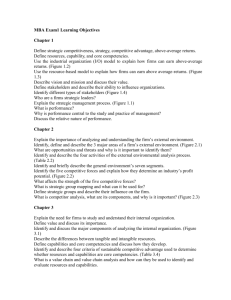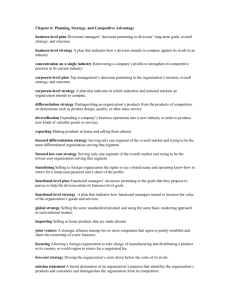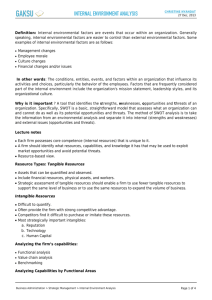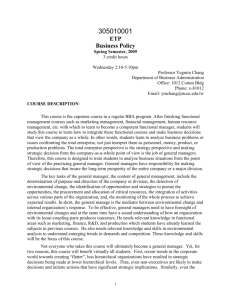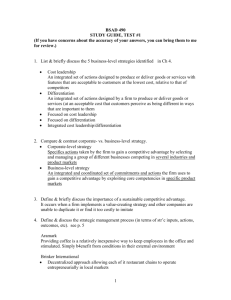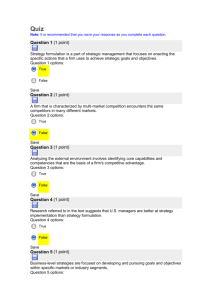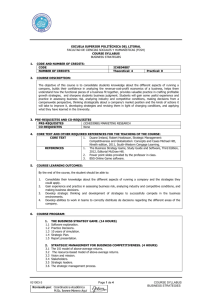下载全文
advertisement
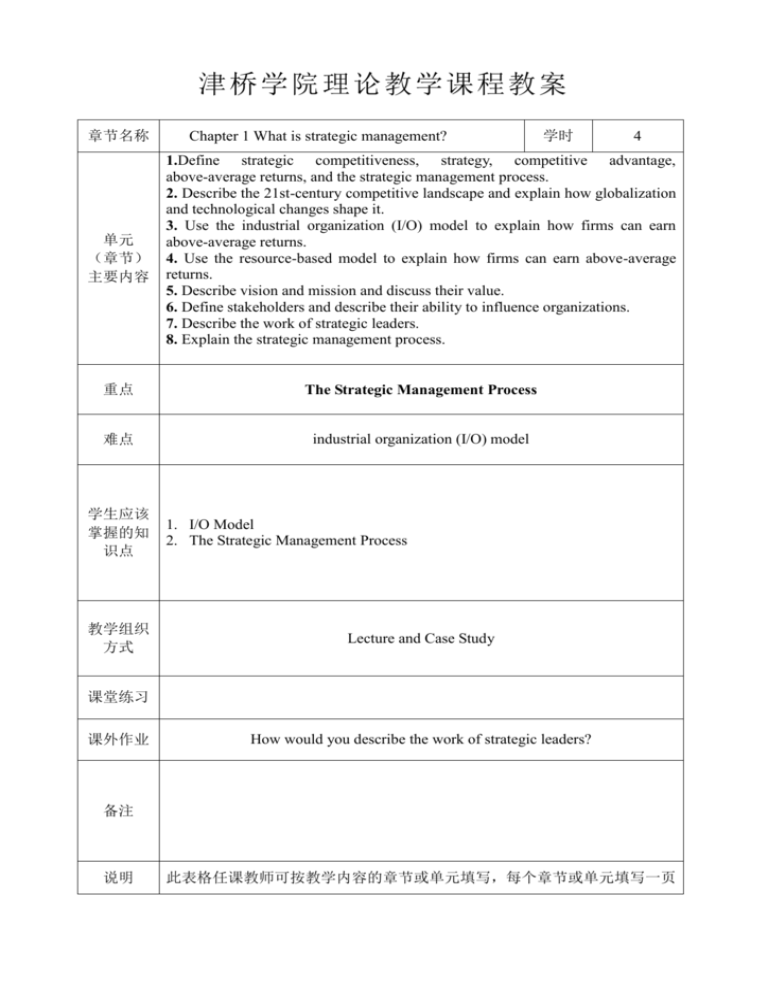
津桥学院理论教学课程教案 章节名称 Chapter 1 What is strategic management? 学时 4 单元 (章节) 主要内容 1.Define strategic competitiveness, strategy, competitive advantage, above-average returns, and the strategic management process. 2. Describe the 21st-century competitive landscape and explain how globalization and technological changes shape it. 3. Use the industrial organization (I/O) model to explain how firms can earn above-average returns. 4. Use the resource-based model to explain how firms can earn above-average returns. 5. Describe vision and mission and discuss their value. 6. Define stakeholders and describe their ability to influence organizations. 7. Describe the work of strategic leaders. 8. Explain the strategic management process. 重点 The Strategic Management Process 难点 industrial organization (I/O) model 学生应该 掌握的知 识点 教学组织 方式 1. I/O Model 2. The Strategic Management Process Lecture and Case Study 课堂练习 课外作业 How would you describe the work of strategic leaders? 备注 说明 此表格任课教师可按教学内容的章节或单元填写,每个章节或单元填写一页 津桥学院理论教学课程教案 章节名称 Chapter 2 Exploring the External Environment: Competition and Opportunities 学时 4 1. Explain the importance of analyzing and understanding the firm’s external environment. 2. Define and describe the general environment and the industry environment. 3. Discuss the four activities of the external environmental analysis process. 单元 (章节) 主要内容 4. Name and describe the general environment’s six segments. 5. Identify the five competitive forces and explain how they determine an industry’s profit potential. 6. Define strategic groups and describe their influence on the firm. 7. Describe what firms need to know about their competitors and different methods (including ethical standards) used to collect intelligence about them. 重点 Name and describe the general environment’s six segments. 难点 what firms need to know about their competitors and different methods 学生应该 掌握的知 识点 教学组织 方式 1. The Importance of Analyzing and Understanding the Firm’S External Environment 2. Five Competitive Forces 3. Strategic Groups and Their Influence to the Firm. Lecture and Case Study 课堂练习 课外作业 备注 说明 此表格任课教师可按教学内容的章节或单元填写,每个章节或单元填写一页 津桥学院理论教学课程教案 章节名称 Chapter 3 Examining the Internal Organization: Activities, Resources, and Capabilities 学时 4 1. Explain the need for firms to study and understand their internal environment. 2. Define value and discuss its importance. 3. Describe the differences between tangible and intangible resources. 4. Define capabilities and discuss how they are developed. 单元 (章节) 主要内容 5. Describe four criteria used to determine whether resources and capabilities are core competencies. 6. Explain how value chain analysis is used to identify and evaluate resources and capabilities. 7. Define outsourcing and discuss the reasons for its use. 8. Discuss the importance of identifying internal strengths and weaknesses. 重点 The Internal Organization’s Value and Its Importance 难点 Value Chain Analysis 学生应该 掌握的知 识点 教学组织 方式 1. The Differences between Tangible and Intangible Resources. 2. The Importance of Identifying Internal Strengths and Weaknesses Lecture and Case Study 课堂练习 课外作业 What is value chain analysis? 备注 说明 此表格任课教师可按教学内容的章节或单元填写,每个章节或单元填写一页 津桥学院理论教学课程教案 章节名称 Chapter 4 Building and Sustaining Competitive Advantage 学时 4 1. Define competitors, competitive rivalry, competitive behavior, and competitive dynamics. 2. Describe market commonality and resource similarity as the building blocks of a competitor analysis. 单元 (章节) 主要内容 3. Explain awareness, motivation, and ability as drivers of competitive behavior. 4. Discuss factors affecting the likelihood a competitor will take competitive actions. 5. Discuss factors affecting the likelihood a competitor will respond to actions taken against it. 6. Explain competitive dynamics in slow-cycle, fast-cycle, and standard-cycle markets. 重点 Describe market commonality and resource similarity as the building blocks of a competitor analysis. 难点 Competitive Dynamics in Slow-Cycle, Fast-Cycle, and Standard-Cycle Markets. 学生应该 掌握的知 识点 1. Define competitors, competitive rivalry, competitive behavior, and competitive dynamics 2. Explain awareness, motivation, and ability as drivers of competitive behavior 教学组织 方式 Lecture and Case Study 课堂练习 课外作业 备注 说明 此表格任课教师可按教学内容的章节或单元填写,每个章节或单元填写一页 津桥学院理论教学课程教案 章节名称 Chapter 5 Strategy at the Business Level 学时 4 1. Define business-level strategy. 2. Discuss the relationship between customers and business-level strategies in terms of 单元 (章节) 主要内容 who,what, and how. 3. Explain the differences among business-level strategies. 4. Use the five forces of competition model to explain how above-average returns can be earned through each business-level strategy. 5. Describe the risks of using each of the business-level strategies. The Relationship between Customers and Business-Level Strategies in Terms of Who,What, 重点 and How. 难点 学生应该 掌握的知 识点 教学组织 方式 The Differences among Business-Level Strategies 1. 2. 3. 4. 5. 6. Business-Level Strategies Market segmentation Cost leadership strategy The differentiation strategy The focus strategy TQM Lecture and Case Study 课堂练习 课外作业 备注 说明 此表格任课教师可按教学内容的章节或单元填写,每个章节或单元填写一页 津桥学院理论教学课程教案 章节名称 Chapter 6 Corporate-Level Strategy 学时 4 1. Define corporate-level strategy and discuss its purpose. 2. Describe different levels of diversification with different corporate-level strategies. 单元 (章节) 主要内容 3. Explain three primary reasons firms diversify. 4. Describe how firms can create value by using a related diversification strategy. 5. Explain the two ways value can be created with an unrelated diversification strategy. 6. Discuss the incentives and resources that encourage diversification. 7. Describe motives that can encourage managers to over diversify a firm. 重点 Different levels of diversification with different corporate-level strategies. 难点 How firms can create value by using a related diversification strategy 学生应该 掌握的知 识点 教学组织 方式 1. 2. 3. 4. Corporate-level strategy Economies of scope Corporate-level core competencies Multipoint competition Lecture and Case Study 课堂练习 课外作业 备注 说明 此表格任课教师可按教学内容的章节或单元填写,每个章节或单元填写一页 津桥学院理论教学课程教案 章节名称 Chapter 7 Acquisition and Restructuring Strategies 学时 4 1. Explain the popularity of acquisition strategies in firms competing in the global economy. 2. Discuss reasons why firms use an acquisition strategy to achieve strategic competitiveness. 单元 (章节) 主要内容 3. Describe seven problems that work against developing a competitive advantage using an acquisition strategy. 4. Name and describe attributes of effective acquisitions. 5. Define the restructuring strategy and distinguish among its common forms. 6. Explain the short- and long-term outcomes of the different types of restructuring strategies. 重点 The short- and long-term outcomes of the different types of restructuring strategies 难点 Name and describe attributes of effective acquisitions 学生应该 掌握的知 识点 1. Seven primary problems that affect a firm’s eddorts to successfully use an acquistion stategy? 2. The restructuring stategy 教学组织 方式 Lecture and Case Study 课堂练习 Why are acuistion strategies popular in many firms competing in the global economy? 课外作业 备注 说明 此表格任课教师可按教学内容的章节或单元填写,每个章节或单元填写一页 津桥学院理论教学课程教案 章节名称 Chapter 8 International Strategy 学时 4 1. Explain traditional and emerging motives for firms to pursue international diversification. 2. Explore the four factors that lead to a basis for international business-level strategies. 3. Define the three international corporate-level strategies: multidomestic, global, and 单元 (章节) 主要内容 transnational. 4. Discuss the environmental trends affecting international strategy, especially liability of foreignness and regionalization. 5. Name and describe the five alternative modes for entering international markets. 6. Explain the effects of international diversification on firm returns and innovation. 7. Name and describe two major risks of international diversification. 8. Explain why the positive outcomes from international expansion are limited. 重点 The four factors that lead to a basis for international business-level strategies 难点 The three international corporate-level strategies 学生应该 掌握的知 识点 教学组织 方式 1. 2. 3. 4. 5. An international strategy A multidomestic stategy A global strategy A transnational strategy International diversitication Lecture and Case Study 课堂练习 课外作业 What is the relationship between international diversification and innovation? 备注 说明 此表格任课教师可按教学内容的章节或单元填写,每个章节或单元填写一页 津桥学院理论教学课程教案 章节名称 Chapter 9 Cooperative Strategy 学时 4 1. Define cooperative strategies and explain why firms use them. 2. Define and discuss three types of strategic alliances. 3. Name the business-level cooperative strategies and describe their use. 单元 (章节) 主要内容 4. Discuss the use of corporate-level cooperative strategies in diversified firms. 5. Understand the importance of cross-border strategic alliances as an international cooperative strategy. 6. Explain cooperative strategies’ risks. 7. Describe two approaches used to manage cooperative strategies. 重点 Three types of strategic alliances 难点 Understand the importance of cross-border strategic alliances as an international cooperative strategy. 学生应该 掌握的知 识点 教学组织 方式 1. 2. 3. 4. 5. 6. Cooperative strategy A strategic alliance A joint venture An equity strategic alliance Business-level cooperative strategy A diversifying strategic alliance Lecture and Case Study 课堂练习 课外作业 What risks are firms likely to experience as they use cooperative strategies? 备注 说明 此表格任课教师可按教学内容的章节或单元填写,每个章节或单元填写一页 津桥学院理论教学课程教案 章节名称 Chapter 10 Corporate Governance 学时 4 1. Define corporate governance and explain why it is used to monitor and control managers’ strategic decisions. 2. Explain why ownership has been largely separated from managerial control in the modern corporation. 3. Define an agency relationship and managerial opportunism and describe their strategic implications. 单元 (章节) 主要内容 4. Explain how three internal governance mechanisms— ownership concentration, the board of directors, and executive compensation—are used to monitor and control managerial decisions. 5. Discuss the types of compensation executives receive and their effects on strategic decisions. 6. Describe how the external corporate governance mechanism—the market for corporate control—acts as a restraint on top-level managers’ strategic decisions. 7. Discuss the use of corporate governance in international settings, in particular in Germany and Japan. 重点 Why ownership has been largely separated from managerial control in the modern corporation. 难点 How three internal governance mechanisms— ownership concentration, the board of directors, and executive compensation—are used to monitor and control managerial decisions. 学生应该 掌握的知 识点 1. 2. 3. 4. Corporate governance Managerial opportunism Institutional owners Executive compensation 教学组织 方式 Lecture and Case Study 课堂练习 How is each of the three internal governance mechanisms ownership concentration, doards of directors, and executive coompensation-used to align the interests of managerial agents with those of the firm/s owners? 课外作业 备注 说明 此表格任课教师可按教学内容的章节或单元填写,每个章节或单元填写一页 津桥学院理论教学课程教案 章节名称 Chapter 11 Organizational Structure and Controls 学时 4 1. Define organizational structure and controls and discuss the difference between strategic and financial controls. 2. Describe the relationship between strategy and structure. 单元 (章节) 主要内容 3. Discuss the functional structures used to implement business-level strategies. 4. Explain the use of three versions of the multidivisional (M-form) structure to implement different diversification strategies. 5. Discuss the organizational structures used to implement three international strategies. 6. Define strategic networks and discuss how strategic center firms implement such networks at the business, corporate and international levels. 重点 Organizational structure 难点 The functional structures used to implement business-level strategies 学生应该 掌握的知 识点 教学组织 方式 1. 2. 3. 4. 5. Organizational structure Organizational control Strategic controls The functional structure SBU form Lecture and Case Study 课堂练习 课外作业 What does it mean to say that strategy and structure have a reciprocal relationship? 备注 说明 此表格任课教师可按教学内容的章节或单元填写,每个章节或单元填写一页 津桥学院理论教学课程教案 章节名称 Chapter 12 Strategic Leadership 学时 4 1. Define strategic leadership and describe the importance of top-level managers. 2. Define top management teams and explain their effects on firm performance. 3. Describe the managerial succession process using internal and external managerial labor markets. 单元 (章节) 主要内容 4. Discuss the value of strategic leadership in determining the firm’s strategic direction. 5. Describe the importance of strategic leaders in managing the firm’s resources, with emphasis on exploiting and maintaining core competencies, human capital, and social capital. 6. Define organizational culture and explain what must be done to sustain an effective culture. 7. Explain what strategic leaders can do to establish and emphasize ethical practices. 8. Discuss the importance and use of organizational controls. 重点 The importance of top-level managers. 难点 The value of strategic leadership in determining the firm’s strategic direction 学生应该 掌握的知 识点 教学组织 方式 1. 2. 3. 4. Strategic leadership International and external managerial labor market Determining the strategic direction Human capital Lecture and Case Study 课堂练习 课外作业 What is organizational culture? 备注 说明 此表格任课教师可按教学内容的章节或单元填写,每个章节或单元填写一页
